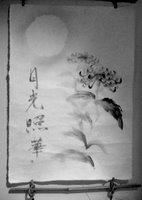2006 September: Benoit - Ink Paintings

 Classics of Japanese Brush Painting
Classics of Japanese Brush PaintingBy Rebecca Benoit
& Majka Broulik
September 9-10, 2006
Brush dances, Ink sings.
Chinese Proverb
Introduction to Sumi-e or Sui-boku-ga
SUMI-E Defined: Sumi-e (ink picture) or Sui-boku-ga (ink-water art) is a traditional art form dating back thousands of years from Asia (primarily China and Japan).
Materials
Black Ink used in brush painting is made of black pine soot, bonded with a gelatin and molded into a stick and then ground on a hard, fine-textured stone called “suzuri” with a small amount of water.
Brushes are usually made with bamboo handles and animal hair. With proper care, they can last for years.
Rice paper is lovely, but unforgiving. As the material of choice for painters, it gives no second chances like watercolour paper. Rice paper allows no mistakes or touchups: artists have only one chance to do a painting – or begin again on new paper.
Felt is used under the delicate rice paper and protects the desk from any ink or water as well as ensuring the delicate painting does not stick to any surface.
Calligraphy is at the foundation of all brush painting. For example, the bamboo joint is painted using the character ‘one’.
Painters adjust the tone (or colour) of the ink by adding water and add texture with different brush strokes (dry or very wet).
Space is vital, in Sumi-e, embracing the balance between white and black, and inviting the viewer to ‘complete’ the painting.
Sumi-e does not seek to copy, but rather to find the essence of the item. Expressing the chosen object through dynamic, vital and elegant strokes, the artist depicts the spirit of the subject.
The Four Gentlemen): plum tree, wild orchid, bamboo, and chrysanthemum, represent each of the four seasons and form the core curriculum of Sumi-e.
“Be forceful with Summer’s bamboo, but delicate and sparing with Spring’s Chinese orchid.”
Hirayama 1979, Tuttle Press
Basic mastery of these forms gives the artist the techniques required to paint virtually all other subjects.
“Strength and vigor in each stroke contribute to the overall force of a painting.. strong strokes make a vibrant painting, and indecisive strokes make a weak one. “
(Frame, 2002, Sterling).
ARTIST STATEMENT: BENOIT
In 1998 when I began my brush painting studies in Japan, I lived in a concrete neighborhood. Suffocating under wires and within concrete, I sought out nature, and concentrated on the Foundation Four. Over the seven years I studied in Japan, my eye gradually began to drift towards the lyrical willows, perfect rows of pines, or temples and shrines with their ancient staircases of stone.
My favourite here is that of Horaiwa, a rugged water-worn stone, with a few tiny pine trees clinging to life, sculpted by the wind and waves. The image itself, of one of my favourite walks along the ocean, pleased me to paint. But it was the partnership with Yoko Tamaki, Haiku poet in Japan, that elevates this piece from mere painting, to delightful marriage of image and words. Together we worked on over 60 paintings to be exhibited in 2007.
I so enjoyed working with another artist that I called upon calligraphers of everyday for the Sayonara Project. In the hours before my return to Canada, friends, family and colleagues poured into my studio from morning to night. In 45 days, I worked feverishly on over 300 paintings, producing only 2 prints of each: one for me, and the other a gift to the calligrapher. In exchange for a one-of-a-kind painting, they gave me the gift of a message. Thus, this treasured collection represents a unique and rare combination of artistry, enhanced with a calligraphic message, all on beautiful rare hand-made paper imported from Thailand. It is my hope that this fusion of visual art, poetry and the medium itself delight both eye and soul.
ARTIST BIO
Rebecca Benoit studied under Master Hiroshi Tamaki in Japan for 7 years. Her intensive curriculum of study involved over 2,000 hours of private instruction in Suibokuga.
Rebecca teaches the basic foundation four in her home evenings and weekends to both groups and individuals. Classes are a maximum of 5 students and private lessons are also available. Contact her directly for more details on class times and cost. Contact her at: beccabenoit[at]yahoo.com
